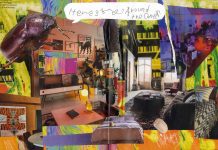To people unfamiliar with the Gorlok, it may come across as an abomination of mismatched parts. To the students of Webster University, the Gorlok stands as the mythological embodiment of ideals that the school prides itself on.
The Gorlok has been the proud mascot of Webster since its creation over 30 years ago. The creature has three distinct features: the horns of a bison, the head of a Saint Bernard and the paws of a cheetah. Although the Gorlok is a mythical beast, its currently defined anatomy does not present a full picture of what this creature would look like if it existed.
The Gorlok was designed in 1984 through a school sponsored contest that both faculty and students were encouraged to participate in. Each characteristic given to the Gorlok embodies a specific trait that Webster University is proud to stand for. The horns of a bison showcase strength and fierceness. The paws of a cheetah demonstrate speed and agility. The face of the Saint Bernard shows that though the school is competitive, the qualities of good conduct and dependability are just as important. The name Gorlok is a clever combination of two main streets in Webster Groves, Gore Avenue and Lockwood Avenue.
In order to determine if the Gorlok could exist in nature there is one key characteristic that must be defined. From a physiological standpoint the biggest piece to the puzzle is the torso. Dr. Stephanie Schroeder, the head of the Biology department at Webster points out that there are several details that need to be taken into consideration.
“We are talking about a furry mammal that is fast and can walk very well for short distances, and bears can certainly walk on two legs for short distances. We are essentially talking about a bear with horns,” Schroeder said.
Bears, particularly grizzly bears, are infamously large creatures who are well known for their incredible speed and ferocity. These characteristics make grizzly bears the perfect candidate to define the Gorlok’s torso.
Using the torso of a grizzly bear in the physiology means that the Gorlok could very well exist in nature, and would be incredibly versatile in its habitat location and hunting capabilities. Using the more complete body composition, several characteristics can be determined about the mascot:
- Each of the animals that the mascot is based on are placental mammals; meaning that the Gorlok would give birth to live offspring and would be a nurturing parent.
- In order to maintain its incredible speed, a wild Gorlok would primarily be a carnivore with a high metabolism. The teeth of the Saint Bernard and the strong digestive system of a bear would allow the creature to utilize any prey for food.
- The fur that covers the entirety of the Gorlok leads Schroeder to believe that this animal would likely live in northern climates where temperatures get low.
- The cheetah stands as the outlier of the animals the mascot is based on. However, the cheetah is the only member of the feline family that doesn’t retract its claws, much like dogs and bears.
There is one trait that calls the plausibility of its existence into question. The Gorlok is covered in bright yellow fur symbolizing Webster University’s school colors alongside the blue jersey commonly worn. Schroeder believes this would work against the hunting capabilities of the Gorlok.
“I think the body type is realistic, but I’m not exactly sure what environment that bright yellow coat would fit into,” Schroeder said. “Most animals blend into their environment as a camouflage in order to hunt prey. There are not many places in the world that the yellow would benefit him.”
The grizzly bear and cheetah both utilize the color of their fur to stalk prey in their natural environment. With snow covering the ground, a Gorlok would stick out like a sore thumb to any other predators. Blending in would be a problem, but it ultimately does not affect the possibility of the creature’s existence.
Taking the fur color and its many other characteristics into consideration there is only one conclusion to be reached. The Gorlok is an apex predator standing proudly atop of the food chain. It would have no natural predators and in fact would be competition against other top predators. It is a brutally ruthless killing machine able to take down opponents of all sizes.



